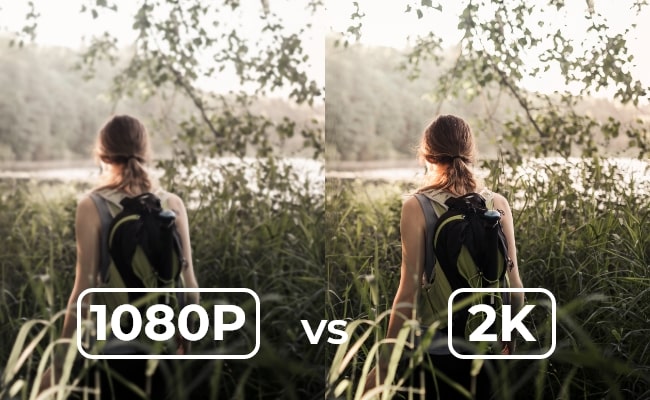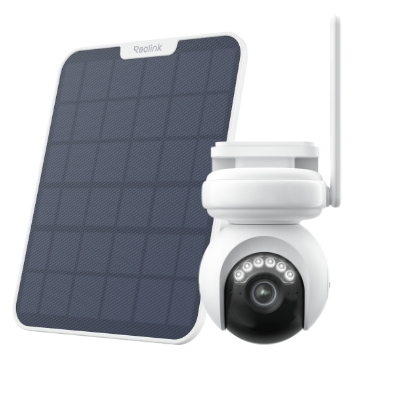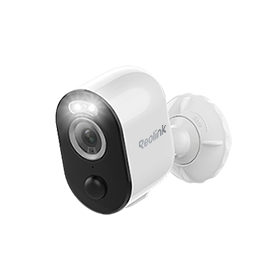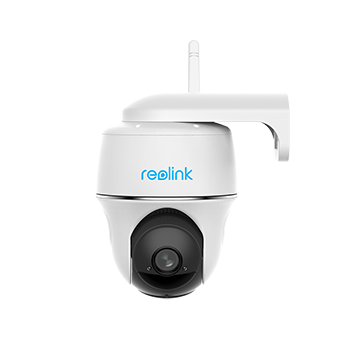2K vs. 1080p: What's the Difference?

The resolution of screens and displays is essential when purchasing new devices like TVs, computer monitors, security cameras, etc. Two of the most common resolutions you'll see are 1080p and 2K. But what exactly do those terms mean, and what's their difference?
Understanding the distinction between 2K vs 1080p resolutions is crucial in choosing the proper display or camera for your needs regarding image quality, field of view, storage capacity required, and costs. This article will compare 1080p vs. 2k to help you determine which is better for various use cases.
- 2K vs. 1080p: What's the Real Difference?
- 1080p vs. 2K: Understanding the Basics
- 1080p vs 2K Security Camera: Which One to Choose
- 2K vs. 1080p: Other Applications
- 1080p vs. 2K vs 4K: Comparison Table
- Best 2K Security Camera Recommendation
- 2K vs. 1080p vs. 16MP Security Cameras: How They Differ?
- FAQs
- Conclusion
2K vs. 1080p: What's the Real Difference?
The main difference between 2K and 1080p is in the number of horizontal pixels that make up the resolution: while 1080p has a resolution of about 2 million total pixels (1920x1080), 2K can have over 3 million pixels (2560x1440p), making it the sharper and more detailed display option.
- 1080p refers to a display resolution of 1920 x 1080 pixels. The "p" stands for "progressive scan."
- 2K refers to a horizontal display resolution approximately 2000 pixels wide. Common 2K resolutions include 2048 x 1080 and 2560 x 1440.
1080p vs. 2K: Understanding the Basics
The competition between 2K resolution vs. 1080p should start with understanding their basic definitions.
What is 1080p?
1080p refers to the display resolution of 1920 x 1080 pixels. It gets its name because it has a horizontal pixel count of close to 1080. The "p" indicates that it uses progressive scanning, which displays all the horizontal lines of pixels in each frame.
1080p is considered full high definition (HD) and can smoothly display video content at that resolution. It's the minimum resolution for Blu-ray discs. 1080p matches the native resolution of most affordable consumer TV sets and computer monitors.
What is 2K?
2K refers to a horizontal display resolution of approximately 2000 pixels. Unlike 1080p, 2K is not an official consumer electronics terminology nor a single set display resolution.
Common 2K resolutions include:
- 2048 × 1080
- 2560 × 1440 (WQHD)
- 2560 × 1600
So, 2K encompasses varying resolutions that have around 2000 pixels horizontally. Many 2K resolution options have an aspect ratio of 16:9, which matches most video formats. 2K resolutions offer more pixels and detail than 1080p. This allows for sharper imagery. 2K is considered the minimum resolution for digital cinema projectors.
1080p vs 2K Security Camera: Which One to Choose
When choosing between purchasing a 1080p vs 2K security camera system for home or business surveillance, there are several factors to weigh, like image quality, field of view, bandwidth usage, storage requirements, and costs. Here is how to choose between 1080p vs. 2K vs 4K security cameras:
Image Quality
A 2K security camera can capture video at resolutions up to 2560 x 1440 pixels, whereas 1080p maxes out at 1920 x 1080 pixels. So, 2K security cameras render images with over twice the number of pixels as 1080p cameras. This leads to more precise, more detailed video footage.
But in most cases, 2K and 1080p security camera resolutions offer sufficiently detailed video streams for security purposes. Unless you need to capture license plates or make out tiny details, 1080p cameras should suffice for general property monitoring.
Field of View
Most security cameras use wide-angle lenses with fields of view (FOV) between 80° to 120°. A 2K vs 1080p camera with the same lens angle will cover the same area. The 2K camera will show that area with more resolution.
So, if covering a particular space with one 1080p vs. 2k camera is preferred, the FOV depends on lens specifications, not the display resolution.
Storage Consumption
Higher resolution 2K security cameras will consume 2-3x more storage than 1080p cameras since their video contains many more pixels. Footage from just a few 2K cameras can quickly fill up internal hard drives or memory cards. Large microSD cards become necessary for continuous capture. Users will need to invest in higher storage capacity if going with 2K. This can raise long-term data management costs.
Cost
Previously, 2K cameras were substantially more expensive than 1080p cameras. But with 2MP+ cameras becoming mainstream in the security market, costs of primary 2K cameras have lowered closer to 1080p models. Still, high-end 2K cameras need to be pricier than flagship 1080p options.
For those seeking maximum savings, 1080p remains the value choice. Going with 2K means paying a premium for extra sharpness, which may only provide practical benefits in some situations.
Overall, while 2K security cameras capture more detailed video, that may be overkill for some use cases.
In many cases, 1080p offers sufficient resolution for basic surveillance needs at lower storage and hardware costs. But declining prices of 2K cameras are making the upgrade increasingly affordable.
2K vs. 1080p: Other Applications
The 2K vs. 1080p resolution debate extends to other devices beyond just security cameras and televisions. Which resolution is "better" depends on the specific usage.
Gaming
For PC 1080p vs. 2k gaming, a 1080p display hits the sweet spot between image sharpness and smooth frame rates that most graphics cards can easily achieve. 2K monitors can look noticeably crisper, but top-tier GPUs become necessary to maintain high framerates at that higher resolution.
Console gaming is typically limited to 1080p output anyway. So, there's often no benefit to higher-resolution displays. For most gamers, 1080p at frame rates above 60fps delivers an excellent experience. 2K is appealing to those wanting maximum visual fidelity and cutting-edge rigs.
Laptop
Laptop manufacturers offer both 1080p and 2K resolution display options across their lineups.
But on the compact screens of 1080p vs. 2k laptops that are viewed up close, the sharper texts and images of 2K displays become more noticeable compared to TVs or security camera feeds.
Also, 2K resolution consumes less laptop battery charge per hour than power-hungry 4K displays.
If laptop mobility is essential, getting a model with an efficient 2K resolution and at least 7 hours of average battery life balances pixel density with portable convenience.
Webcam
Most laptops and mobile devices have front-facing cameras in the 2k vs. 1080p webcam resolution range. At these resolutions, built-in webcams offer decent video chat and conference sharpness. Standalone USB webcams are also commonly 1080p. This resolution is sufficient for casual use cases like virtual meetings and classrooms.
But content creators may prefer standalone 2K webcams capable of capturing finer facial details. The downside is that 2K webcams cost much more than 1080p variants.
So, depending on the application - gaming, laptop displays, or webcams - sticking with tried-and-proven 1080p makes the most sense over opting for sharper 2K or 4K options. But 2K does provide a nice middle ground, offering discernible resolution improvements at a reasonable cost.
1080p vs. 2K vs 4K: Comparison Table
With advancements in resolution technology, 4K has emerged as another alternative. Take a look at the comparison table featuring 1080p, 2K, and 4K to see the differences.
Best 4K Security Camera Recommendation
For the best 4K security camera, I recommend the Reolink Altas PT Ultra, which features true 4K resolution for an ultra-clear 8MP experience, pan and tilt functionality for flexible monitoring, and a long-lasting 20,000mAh battery that ensures up to 12 hours of daily use and lasts up to 8 days on a single charge.
With WiFi 6 capability for a stable connection and fast data transmission, it also offers continuous recording for 24/7 surveillance and intelligent motion detection features to alert you of any activity, making it an excellent choice for home security.
Industry-leading 4K Continuous Recording Battery Camera
4K UHD Continuous Recording; ColorX Night Vision; Pan & Tilt; Automatic Tracking; All Recordings Stored Locally.
Best 2K Security Camera Recommendation
For those seeking a robust outdoor security camera with superior 2K video quality, an excellent option to consider is the Reolink Argus 3 Pro.
The Argus 3 Pro shoots sharp 2K resolution footage and leverages intelligent analytics to discern people and vehicles accurately. Despite having advanced features, it requires no elaborate setup thanks to its wire-free, battery-powered design enhanced by long-lasting solar charging capabilities.
Key aspects that make the Argus 3 Pro a top-rated 2K security camera include:
- Person/Vehicle Detection
- Color Night Vision
- 2K 4MP Super HD
- Seamless WiFi Connection
- Rechargeable Battery
- Solar-Powered
2K 100% Wire-Free Spotlight Camera
2K 4MP Super HD, Battery/Solar Powered, Person/Vehicle Detection, 5/2.4 GHz Dual-Band WiFi, Color Night Vision, Two-Way Audio.
If you are looking for a 2K+ security camera, Reolink Argus PT is a good choice. This camera offers 2K+ 5MP resolution for clear and detailed video footage, making it ideal for capturing finer details. Its pan and tilt functionality allows for a broader coverage area, ensuring you can monitor large spaces effectively. The Reolink Argus PT is also equipped with night vision, providing clear video even in low-light conditions.
Additionally, it is compatible with Alexa.enabling hands-free control and integration with your smart home ecosystem. You can easily view live footage, control the camera, and receive notifications through Alexa-enabled devices.
100% Wire-Free PT Camera
2K+ 5MP Super HD; 5GHz/2.4GHz WiFi; Rechargeable Battery & Solar Powered; 355° Pan & 140° Tilt; IP65 Certified Weatherproof; Color Night Vision; 2-Way Audio; 122° Wide Viewing Angle.
2K vs. 1080p vs. 16MP Security Cameras: How They Differ?
The main distinction between these devices lies in their pixel count. As mentioned earlier, 2K security cameras boast about 4 million pixels in total, while 1080p cameras only have 2 million. However, opting for a 16MP model allows you to enjoy a whopping 16 million pixel dots in just one image.
Reolink's latest 16MP security camera, the Duo 3 PoE, offers unparalleled clarity compared to 2K and 1080p models. It integrates two lenses into one housing, creating a 180-degree ultra-wide field of view. Users can explore finer details and cater to their specific surveillance needs.
Groundbreaking 16MP Dual-Lens PoE Camera
16MP UHD, Dual-Lens, Motion Track, 180° Wide Viewing Angle, Power over Ethernet, Color Night Vision.
FAQs
Which is better 2K or 1080p?
2K resolution is better than 1080p, with at least twice the number of pixels, resulting in sharper, more detailed video footage. But 1080p resolution remains sufficient for essential monitoring and surveillance in many home and business use cases.
What is the difference between 2K and 1080p dash cam?
Dash cameras capture crucial driving incident footage from right inside the car. A 1080p dash cam offers adequate sharpness at an affordable price point for most users. 2K models render license plates and street signs more legibly but cost extra.
Is 1080p enough for a security camera?
In most cases, 1080p resolution provides enough clarity to recognize faces, clothing colors, and vehicle logos and read text seen within the camera's field of view. For general home surveillance applications, reasonably priced 1080p security cameras should meet requirements. Upgrading to 2K makes sense if you want to capture finer details like license plate digits from further away.
Conclusion
Determining whether 2K or 1080p resolution is "better" depends significantly on the use case application, viewing distance, budget constraints, storage capacity available, and other aspects. When buying new displays, recording devices, or security cameras, understanding the critical distinctions between 1080p and 2K allows matching resolution choices to practical needs and expectations.
After reviewing this article, have you grasped the differences between 2K and 1080p? Please drop your thoughts in the comments; we're eager to hear from you!
Search
Be in the Know
Security insights & offers right into your inbox




